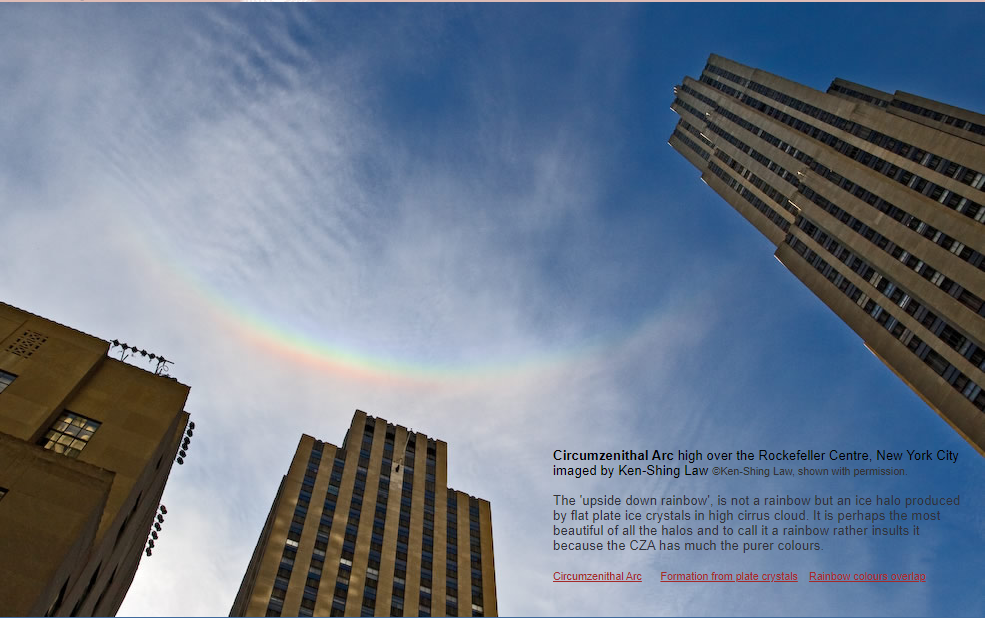New York Circumzenithal Arc
The Enchanting Beauty of the New York Circumzenithal Arc
Have you ever looked up at the sky and been captivated by a mesmerizing display of colors that seemed to defy gravity? If you've been fortunate enough to witness a New York Circumzenithal Arc (CZA), then you know exactly what I'm talking about. Often referred to as an "upside-down rainbow," the CZA is not actually a rainbow at all. Instead, it is a rare atmospheric phenomenon created by flat plate ice crystals in high cirrus clouds. In fact, the CZA boasts even purer colors than a rainbow, making it a truly breathtaking sight.
Understanding the Science Behind the CZA
To fully appreciate the wonder of the New York Circumzenithal Arc, it's important to understand the science behind it. The CZA occurs when sunlight interacts with ice crystals in the atmosphere, specifically those found in cirrus clouds. These ice crystals act as tiny prisms, bending and refracting light in a unique way. When the sunlight passes through these ice crystals at a specific angle, it creates a stunning display of colors in the form of an arc.
The Unique Characteristics of the CZA
One of the most remarkable aspects of the New York Circumzenithal Arc is its shape. Unlike a traditional rainbow that forms a semicircle, the CZA appears as an upside-down or inverted rainbow. This distinctive shape is caused by the refraction of sunlight through the flat plate ice crystals, which results in a bending of light at such an angle that it forms an arc that is positioned above the zenith.
The Spectacular Colors of the CZA
While rainbows are renowned for their vibrant colors, the New York Circumzenithal Arc takes color display to a whole new level. The CZA showcases incredibly pure and intense hues, often appearing more vivid than those seen in a rainbow. This phenomenon is due to the unique properties of the ice crystals involved in its formation. The flat plate shape of these crystals allows for a more efficient separation and dispersion of light, resulting in a dazzling array of colors that seem to dance across the sky.
Where and When to Spot the CZA
The New York Circumzenithal Arc is a relatively rare occurrence, making it all the more special when it graces the skies above the Big Apple. To have the best chance of spotting this enchanting phenomenon, it's important to know where and when to look. The CZA is most commonly seen in regions located between 22 and 55 degrees latitude, where cirrus clouds are prevalent. In New York City, the best time to catch a glimpse of the CZA is during the winter months when cirrus clouds are more common.
Capturing the Beauty of the CZA
If you're lucky enough to witness a New York Circumzenithal Arc, you'll undoubtedly want to capture its beauty for posterity. To photograph this awe-inspiring phenomenon, it's essential to have the right equipment and technique. Using a wide-angle lens and a polarizing filter can help enhance the colors and details of the CZA. Additionally, adjusting your camera settings to a higher shutter speed and smaller aperture can help capture the intricate details of the ice crystals and the vibrant hues they produce.
The Cultural Significance of the CZA
Beyond its scientific marvels, the New York Circumzenithal Arc holds cultural significance for many. Throughout history, rainbows and other atmospheric phenomena have been regarded as symbols of hope, transformation, and divine presence. The CZA's ethereal beauty has inspired artists, poets, and dreamers alike, serving as a reminder of the awe-inspiring wonders that exist in our world. Its fleeting nature and elusive appearance make it all the more cherished by those fortunate enough to witness its splendor.
Conclusion
The New York Circumzenithal Arc is a testament to the breathtaking beauty and complexity of our atmosphere. Created by the interaction of sunlight with flat plate ice crystals in cirrus clouds, the CZA presents an inverted arc of intensely pure colors that surpass the brilliance of a traditional rainbow. Its rarity and elusive nature make it a treasured sight for those lucky enough to experience it. So, the next time you find yourself gazing at the sky, remember to keep your eyes peeled for the enchanting wonder of the New York Circumzenithal Arc.

Circumzenithal Arc high over the Rockefeller Centre, New York City imaged by Ken-Shing Law ©Ken-Shing Law, shown with permission.
The 'upside down rainbow', is not a rainbow but an ice halo produced by flat plate ice crystals in high cirrus cloud. It is perhaps the most beautiful of all the halos and to call it a rainbow rather insults it because the CZA has much the purer colours.
Note: this article has been automatically converted from the old site and may not appear as intended. You can find the original article here.
Reference Atmospheric Optics
If you use any of the definitions, information, or data presented on Atmospheric Optics, please copy the link or reference below to properly credit us as the reference source. Thank you!
-
<a href="https://atoptics.co.uk/blog/new-york-circumzenithal-arc-2/">New York Circumzenithal Arc</a>
-
"New York Circumzenithal Arc". Atmospheric Optics. Accessed on November 26, 2024. https://atoptics.co.uk/blog/new-york-circumzenithal-arc-2/.
-
"New York Circumzenithal Arc". Atmospheric Optics, https://atoptics.co.uk/blog/new-york-circumzenithal-arc-2/. Accessed 26 November, 2024
-
New York Circumzenithal Arc. Atmospheric Optics. Retrieved from https://atoptics.co.uk/blog/new-york-circumzenithal-arc-2/.